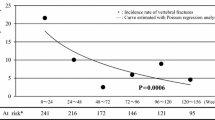Abstract
To determine the clinical recommended dosage regimen of risedronate for the treatment of involutional osteoporosis in Japanese patients, dose-response relationships for the efficacy and safety of this drug were investigated using a multi-center, randomized, double-blind, parallel group comparative design with four dose levels of risedronate (placebo, 1 mg, 2.5 mg and 5 mg per day). A total of 211 patients diagnosed with involutional osteoporosis according to the criteria proposed by the Japanese Society for Bone and Mineral Research were randomized and received one of the four doses once daily for 36 weeks. All patients were supplemented with 200 mg of calcium daily in the form of calcium lactate. The primary efficacy endpoint was the percent change in bone mineral density of the lumbar spine (L2–L4 BMD) determined by dual-energy X-ray absorptiometry (DXA) from baseline to the time of final evaluation. Changes in biochemical markers of bone turnover and safety profile were also compared. Percent changes in L2–L4 BMD at final evaluation in the placebo, and 1-, 2.5-, and 5-mg risedronate groups were 0.79±5.30, 2.71±4.93, 5.29±3.96, and 5.15±4.25% (mean±SD), respectively. A linear dose-response relationship was obtained up to a dose of 2.5 mg, whereas no further increase in BMD was observed at 5 mg. The decrease in bone turnover markers, including N-terminal osteocalcin, phosphorus, and urinary deoxypyridinoline, also showed a linear dose-response relationship up to a dose of 2.5 mg. Alkaline phosphatase level decreased linearly up to a dose of 5 mg. Risedronate was well tolerated in this 36-week study with 1- to 5-mg doses. Neither the overall incidence of adverse events nor the percentage of patients without problem in overall safety assessment differed significantly among the dose groups including the placebo group. Based on these results, a once-daily dose of 2.5 mg of risedronate, which is half that used in Caucasians, is recommended for the treatment of involutional osteoporosis in Japanese patients.





Similar content being viewed by others
References
Harris ST, Watts NB, Genant HK et al. (1999) Effects of risedronate treatment on vertebral and nonvertebral fractures in women with postmenopausal osteoporosis, a randomized, controlled trial. J Am Med Assoc 282:1344–1352
Reginster J-Y, Minne HW, Sorensen OH et al. (2000) Randomized trial of the effects of risedronate on vertebral fractures in women with established postmenopausal osteoporosis. Osteoporos Int 11:83–91
Liberman UA, Weiss SR, Broll J et al. (1995) Effect of oral alendronate on bone mineral density and the incidence of fracture in postmenopausal osteoporosis. N Engl J Med 333:1437–1443
Black DM, Cummings SR, Karpf DB et al. (1996) Randomised trial of effect of alendronate on risk of facture in women with existing vertebral fractures. Lancet 348:1535–1541
McClung MR, Geusens P, Miller PD et al. (2001) Effect of risedronate on the risk of hip fracture in elderly women. N Engl J Med 344:333–340
Nakamura T, Kushida K, Shiraki M et al. (1998) A placebo-controlled, double blind study to determine the appropriate alendronate dosage in Japanese patients with involutional osteoporosis, and postmenopausal osteopenia or artificially menopausal women. Med Consult New Remedies 35:3–17 [in Japanese]
Shiraki M, Kushida K, Fukunaga M et al. (1999) A double-masked multicenter comparative study between alendronate and alfacalcidol in Japanese patients with osteoporosis. Osteoporos Int 10:183–192
Kishimoto H, Kushida K, Shiraki M et al. (2002) A clinical trial evaluating the efficacy and safety of risedronate (NE-58095) in patients with involutional osteoporosis or bone mineral content loss associated with lack of ovarian function: early phase II study of NE-58095. Osteoporosis Jpn 10:61–83 [in Japanese]
Orimo H, Sugioka Y, Fukunaga M et al. (1995) The Committee of the Japanese Society for Bone and Mineral Research for Development of Diagnostic Criteria of Osteoporosis. Diagnostic criteria of primary osteoporosis. Osteoporosis Jpn 3:669–674 [in Japanese]
Brown RC, Aston JP, Weeks I et al. (1987) Circulating intact parathyroid hormone measured by a two-site immunochemiluminometric assay. J Clin Endocrinol Metab 65:407–414
Eguchi H, Hosoda K, Kurihara N et al. (1995) Sandwich immunoassay specific for the N-terminal sequence of osteocalcin. J Immunol Methods 184:213–240
De Leenheer AP, Bauwens RM (1985) Comparison of a cytosol radioreceptor assay with a radioimmunoassay for 1,25-dihydroxyvitamine D in serum or plasma. Clin Chim Acta 152:143–154
Black D, Dunkan A, Robins SP (1988) Quantitative analysis of the pyridinium crosslinks of collagen in urine using ion-paired reverse-phase high-performance liquid chromatography. Anal Biochem 169:197–203
Fogelman I, Ribot C, Smith R et al. (2000) Risedronate reverses bone loss in postmenopausal women with low bone mass: results from a multinational, double-blind, placebo-controlled trial. J Clin Endocrinol Metab 85:1895–1900
Laboratory of Informatics on Health and Nutrition (1999) Sixth revision of recommended dietary allowances (RDA) for the Japanese: dietary reference intakes. Dai-ichi Shuppan Publishing, Tokyo [in Japanese]
Ogura Y, Gonsyo A, Tei M et al. (in press) Phase I clinical trial of risedronate sodium (NE-58095) hydrate: single and multiple oral dose studies. J Bone Miner Metab
Mitchell DY, Eusebio RA, Sacco-Gibson NA et al. (2000) Dose-proportional pharmacokinetics of risedronate on single-dose oral administration to healthy volunteers. J Clin Pharmacol 40:258–265
McClung M, Bensen W, Bolognese M et al. (1998) Risedronate increases bone mineral density at the hip, spine, and radius in postmenopausal women with low bone mass. Osteoporos Int 8 (Suppl 3):111
Author information
Authors and Affiliations
Appendix
Appendix
Committee Members of the Risedronate Late Phase II Study Group
The committee members of the Risedronate Late Phase II Study Group are:
-
Principal Investigator: H. Orimo
-
Steering Committee: Y. Taketani, H. Minaguchi, T. Inoue, R. Morita, H. Morii, K. Yamamoto
-
Central Assessment Committee: K. Kushida, M. Shiraki, M. Fukunaga, H. Kishimoto
-
Controller: Y. Ohashi
Other members of the Risedronate Late Phase II Study Group
The remaining members of the study group are listed in Table 4.
Rights and permissions
About this article
Cite this article
Shiraki, M., Fukunaga, M., Kushida, K. et al. A double-blind dose-ranging study of risedronate in Japanese patients with osteoporosis (a study by the Risedronate Late Phase II Research Group). Osteoporos Int 14, 225–234 (2003). https://doi.org/10.1007/s00198-002-1369-9
Received:
Accepted:
Published:
Issue Date:
DOI: https://doi.org/10.1007/s00198-002-1369-9




